Geothermal energy
Geothermal energy is thermal energy in the Earth's crust. It combines energy from the formation of the planet and from radioactive decay. Geothermal energy has been exploited as a source of heat and/or electric power for millennia.
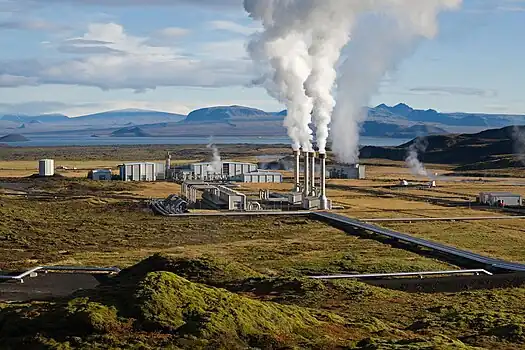
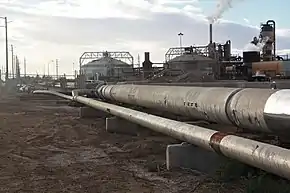
| Part of a series on |
| Renewable energy |
|---|
 |
Geothermal heating, using water from hot springs, for example, has been used for bathing since Paleolithic times and for space heating since Roman times. Geothermal power, (generation of electricity from geothermal energy), has been used since the 20th century. Unlike wind and solar energy, geothermal plants produce power at a constant rate, without regard to weather conditions. Geothermal resources are theoretically more than adequate to supply humanity's energy needs. Most extraction occurs in areas near tectonic plate boundaries.
The cost of generating geothermal power decreased by 25% during the 1980s and 1990s.[1] Technological advances continued to reduce costs and thereby expand the amount of viable resources. In 2021, the U.S. Department of Energy estimated that power from a plant "built today" costs about $0.05/kWh.[2]
In 2019, 13,900 megawatts (MW) of geothermal power was available worldwide.[3] An additional 28 gigawatts provided heat for district heating, space heating, spas, industrial processes, desalination, and agricultural applications as of 2010.[4]
As of 2019 the industry employed about 100 thousand people.[5] Pilot programs like EWEB's customer opt-in Green Power Program suggest that customers would be willing to pay a little more for renewable energy.[6]
The adjective geothermal originates from the Greek roots γῆ (gê), meaning Earth, and θερμός (thermós), meaning hot.
History

Hot springs have been used for bathing since at least Paleolithic times.[7] The oldest known spa is at the site of the Huaqing Chi palace. In the first century CE, Romans conquered Aquae Sulis, now Bath, Somerset, England, and used the hot springs there to supply public baths and underfloor heating. The admission fees for these baths probably represent the first commercial use of geothermal energy. The world's oldest geothermal district heating system, in Chaudes-Aigues, France, has been operating since the 15th century.[8] The earliest industrial exploitation began in 1827 with the use of geyser steam to extract boric acid from volcanic mud in Larderello, Italy.
In 1892, the US's first district heating system in Boise, Idaho was powered by geothermal energy. It was copied in Klamath Falls, Oregon in 1900. The world's first known building to utilize geothermal energy as its primary heat source was the Hot Lake Hotel in Union County, Oregon, beginning in 1907.[9] A geothermal well was used to heat greenhouses in Boise in 1926, and geysers were used to heat greenhouses in Iceland and Tuscany at about the same time.[10] Charles Lieb developed the first downhole heat exchanger in 1930 to heat his house. Geyser steam and water began heating homes in Iceland in 1943.
In the 20th century, geothermal energy came into use as a generating source. Prince Piero Ginori Conti tested the first geothermal power generator on 4 July 1904, at the Larderello steam field. It successfully lit four light bulbs.[12] In 1911, the world's first commercial geothermal power plant was built there. It was the only industrial producer of geothermal power until New Zealand built a plant in 1958. In 2012, it produced some 594 megawatts.[13]
In 1960, Pacific Gas and Electric began operation of the first US geothermal power plant at The Geysers in California.[14] The original turbine lasted for more than 30 years and produced 11 MW net power.[15]
A binary cycle power plant was first demonstrated in 1967 in the USSR and introduced to the US in 1981.[14] This technology allows the generation of electricity from much lower temperature resources than previously. In 2006, a binary cycle plant in Chena Hot Springs, Alaska, came on-line, producing electricity from a record low temperature of 57 °C (135 °F).[16]
In 2021 Quaise Energy announced the idea of using a gyrotron as a boring machine to drill a hole 20 kilometers in depth. The technique used frequencies of 30-300 GHz to transfer energy to rock 1012 (1 trillion) times more efficiently than a laser. Lasers would be disrupted by the vaporized rock, which would effect the gyrotron's longer-wavelength much less. Drilling rates of 70 meters/hour were claimed to be possible with a 1 MW gyrotron.[17]
Resources
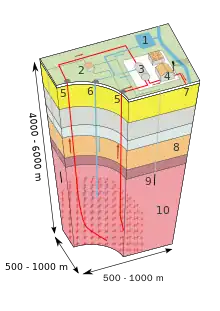
The Earth has an internal heat content of 1031 joules (3·1015 TWh), About 20% of this is residual heat from planetary accretion; the remainder is attributed to past and current radioactive decay of naturally occurring isotopes.[18] For example, a 5275 m deep borehole in United Downs Deep Geothermal Power Project in Cornwall, England, found granite with very high thorium content, whose radioactive decay is believed to power the high temperature of the rock.[19]
Earth's interior temperature and pressure are high enough to cause some rock to melt and the solid mantle to behave plastically. Parts of the mantle convect upward since it is lighter than the surrounding rock. Temperatures at the core–mantle boundary can reach over 4000 °C (7200 °F).[20]
The Earth's internal thermal energy flows to the surface by conduction at a rate of 44.2 terawatts (TW),[21] and is replenished by radioactive decay of minerals at a rate of 30 TW.[22] These power rates are more than double humanity's current energy consumption from all primary sources, but most of this energy flux is not recoverable. In addition to the internal heat flows, the top layer of the surface to a depth of 10 m (33 ft) is heated by solar energy during the summer, and cools during the winter.
Outside of the seasonal variations, the geothermal gradient of temperatures through the crust is 25–30 °C (45–54 °F) per km of depth in most of the world. The conductive heat flux averages 0.1 MW/km2. These values are much higher near tectonic plate boundaries where the crust is thinner. They may be further augmented by combinations of fluid circulation, either through magma conduits, hot springs, hydrothermal circulation.
The thermal efficiency and profitability of electricity generation is particularly sensitive to temperature. Applications receive the greatest benefit from a high natural heat flux most easily from a hot spring. The next best option is to drill a well into a hot aquifer. An artificial one may be built by injecting water to hydraulically fracture bedrock. This last approach is called hot dry rock geothermal energy in Europe, or enhanced geothermal systems in North America.[23]
2010 estimates of the potential for electricity generation from geothermal energy vary sixfold, from 0.035to2TW depending on the scale of investments.[4] Upper estimates of geothermal resources assume wells as deep as 10 kilometres (6 mi), although 20th century wells rarely reached more than 3 kilometres (2 mi) deep.[4] Wells of this depth are common in the petroleum industry.[24]
Geothermal power

Geothermal power is electrical power generated from geothermal energy. Dry steam,, flash steam, and binary cycle power stations have been used for this purpose. As of 2010 geothermal electricity was generated in 26 countries.[26][27]
As of 2019, worldwide geothermal power capacity amounted to 15.4 gigawatts (GW), of which 23.86 percent or 3.68 GW were in the United States.[28]
Geothermal energy supplies a significant share of the electrical power in Iceland, El Salvador, Kenya, the Philippines and New Zealand.[29]
Geothermal power is considered to be renewable energy because the heat extraction is insignificant compared with the Earth's heat content.[22] The greenhouse gas emissions of geothermal electric stations are on average 45 grams of carbon dioxide per kilowatt-hour of electricity, or less than 5 percent of that of coal-fired plants.[30]
| Country | Capacity (MW) 2015[31] |
|---|---|
| United States | 17,415 |
| Philippines | 3 |
| Indonesia | 2 |
| Mexico | 155 |
| Italy | 1,014 |
| New Zealand | 487 |
| Iceland | 2,040 |
| Japan | 2,186 |
| Iran | 81 |
| El Salvador | 3 |
| Kenya | 22 |
| Costa Rica | 1 |
| Russia | 308 |
| Turkey | 2,886 |
| Papua New Guinea | 0.10 |
| Guatemala | 2 |
| Portugal | 35 |
| China | 17,870 |
| France | 2,346 |
| Ethiopia | 2 |
| Germany | 2,848 |
| Austria | 903 |
| Australia | 16 |
| Thailand | 128 |
| Country | Capacity (MW) 2021[32] |
% of national electricity production |
% of global geothermal production (2021) |
|---|---|---|---|
| United States | 3889 | 0.3 | 24.8 |
| Indonesia | 2277 | 3.7 | 14.5 |
| Philippines | 1928 | 27 | 12.3 |
| Turkey | 1676 | 10.7 | |
| New Zealand | 984 | 10 | 6.3 |
| Mexico | 976 | 3 | 6.2 |
| Kenya | 863 | 11.2 | 5.5 |
| Italy | 802 | 1.5 | 5.1 |
| Iceland | 756 | 30 | 4.8 |
| Japan | 481 | 0.1 | 3 |
| Costa Rica | 262 | 14 | 1.7 |
| Iran | |||
| El Salvador | 204 | 25 | 1.3 |
| Nicaragua | 153 | 10 | 1 |
| Russia | 81 | ||
| Papua New Guinea | 56 | ||
| Guatemala | 49 | ||
| Germany | 40 | ||
| Chile | 40 | ||
| Honduras | 39 | ||
| Portugal | 29 | ||
| China | |||
| France | 16 | ||
| Guadeloupe | 15 | ||
| Croatia | 10 | ||
| Ethiopia | 7 | ||
| Austria | 1 | ||
| Australia | 0 | ||
| Total | 15,644 |
Geothermal electric plants were traditionally built on the edges of tectonic plates where high-temperature geothermal resources approach the surface. The development of binary cycle power plants and improvements in drilling and extraction technology enable enhanced geothermal systems over a greater geographical range.[23] Demonstration projects are operational in Landau-Pfalz, Germany, and Soultz-sous-Forêts, France, while an earlier effort in Basel, Switzerland, was shut down after it triggered earthquakes. Other demonstration projects are under construction in Australia, the United Kingdom, and the US.[33] In Myanmar over 39 locations are capable of geothermal power production, some of which are near Yangon.[34]
Geothermal heating
Geothermal heating is the use of geothermal energy to heat buildings and water for human use. Humans have done this since the Paleolithic era. Approximately seventy countries made direct use of a total of 270 PJ of geothermal heating in 2004. As of 2007, 28 GW of geothermal heating satisfied 0.07% of global primary energy consumption.[4] Thermal efficiency is high since no energy conversion is needed, but capacity factors tend to be low (around 20%) since the heat is mostly needed in the winter.
Even cold ground contains heat: below 6 metres (20 ft) the undisturbed ground temperature is consistently at the Mean Annual Air Temperature[35] that may be extracted with a ground source heat pump.
Types
Geothermal energy comes in either vapor-dominated or liquid-dominated forms. Larderello and The Geysers are vapor-dominated. Vapor-dominated sites offer temperatures from 240 to 300 °C that produce superheated steam.
Liquid-dominated plants
Liquid-dominated reservoirs (LDRs) are more common with temperatures greater than 200 °C (392 °F) and are found near volcanoes in/around the Pacific Ocean and in rift zones and hot spots. Flash plants are the common way to generate electricity from these sources. Steam from the well is sufficient to power the plant. Most wells generate 2–10 MW of electricity. Steam is separated from liquid via cyclone separators and drives electric generators. Condensed liquid returns down the well for reheating/reuse. As of 2013, the largest liquid system was Cerro Prieto in Mexico, which generates 750 MW of electricity from temperatures reaching 350 °C (662 °F).
Lower-temperature LDRs (120–200 °C) require pumping. They are common in extensional terrains, where heating takes place via deep circulation along faults, such as in the Western US and Turkey. Water passes through a heat exchanger in a Rankine cycle binary plant. The water vaporizes an organic working fluid that drives a turbine. These binary plants originated in the Soviet Union in the late 1960s and predominate in new plants. Binary plants have no emissions.[13][36]
Enhanced geothermal systems
Enhanced geothermal systems (EGS) actively inject water into wells to be heated and pumped back out. The water is injected under high pressure to expand existing rock fissures to enable the water to flow freely. The technique was adapted from oil and gas fracking techniques. The geologic formations are deeper and no toxic chemicals are used, reducing the possibility of environmental damage. Drillers can employ directional drilling to expand the reservoir size.[13]
Small-scale EGS have been installed in the Rhine Graben at Soultz-sous-Forêts in France and at Landau and Insheim in Germany.[13]
Economics
As with wind and solar energy, geothermal power has minimal operating costs; capital costs dominate. Drilling accounts for over half the costs, and not all wells produce an exploitable resources. For example, a typical well pair (one for extraction and one for injection) in Nevada can produce 4.5 megawatts (MW) and costs about $10 million to drill, with a 20% failure rate, making the average cost of a successful well $50 million.[37]

Drilling geothermal wells is more expensive than drilling oil and gas wells of comparable depth for several reasons:
- Geothermal reservoirs are usually in igneous or metamorphic rock, which is harder to penetrate than the sedimentary rock of typical hydrocarbon reservoirs.
- The rock is often fractured, which causes vibrations that damage bits and other drilling tools.
- The rock is often abrasive, with high quartz content, and sometimes contains highly corrosive fluids.
- The rock is hot, which limits use of downhole electronics.
- Well casing must be cemented from top to bottom, to resist the casing's tendency to expand and contract with temperature changes. Oil and gas wells are usually cemented only at the bottom.
- Well diameters are considerably larger than typical oil and gas wells.[38]
As of 2007 plant construction and well drilling cost about €2–5 million per MW of electrical capacity, while the break-even price was 0.04–0.10 € per kW·h.[11] Enhanced geothermal systems tend to be on the high side of these ranges, with capital costs above $4 million per MW and break-even above $0.054 per kW·h.[39]
Heating systems are much simpler than electric generators and have lower maintenance costs per kW·h, but they consume electricity to run pumps and compressors.
Development
Geothermal projects have several stages of development. Each phase has associated risks. Many projects are canceled during the stages of reconnaissance and geophysical surveys, which are unsuitable for traditional lending. At later stages can often be equity-financed.[40]
Sustainability
Geothermal energy is considered to be sustainable because the heat extracted is so small compared to the Earth's heat content, which is approximately 100 billion times 2010 worldwide annual energy consumption.[4] Earth's heat flows are not in equilibrium; the planet is cooling on geologic timescales. Anthropic heat extraction typically does not accelerate the cooling process.
Wells can further be considered renewable because they return the extracted water to the borehole for reheating and re-extraction, albeit at a lower temperature.
Replacing material use with energy has reduced the human environmental footprint in many applications. Geothermal has the potential to allow further reductions. For example, Iceland has sufficient geothermal energy to eliminate fossil fuels for electricity production and to heat Reykjavik sidewalks and eliminate the need for gritting.[41]


However, local effects of heat extraction must be considered.[22] Over the course of decades, individual wells draw down local temperatures and water levels. The three oldest sites, at Larderello, Wairakei, and the Geysers experienced reduced output because of local depletion. Heat and water, in uncertain proportions, were extracted faster than they were replenished. Reducing production and injecting additional water could allow these wells to recover their original capacity. Such strategies have been implemented at some sites. These sites continue to provide significant energy.[42][43]
The Wairakei power station was commissioned in November 1958, and it attained its peak generation of 173 MW in 1965, but already the supply of high-pressure steam was faltering. In 1982 it was down-rated to intermediate pressure and the output to 157 MW. In 2005 two 8 MW isopentane systems were added, boosting output by about 14 MW. Detailed data were lost due to re-organisations.
Environmental effects
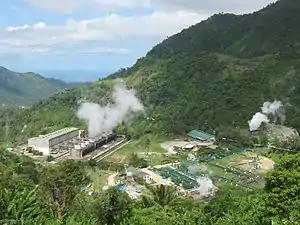
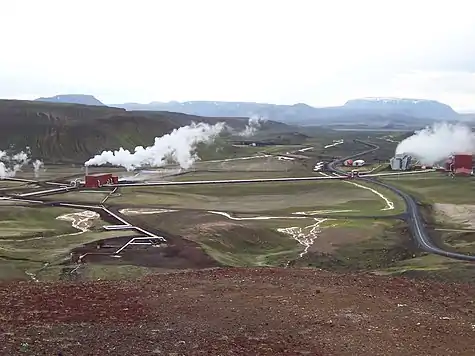
Fluids drawn from underground carry a mixture of gasses, notably carbon dioxide (CO
2), hydrogen sulfide (H
2S), methane (CH
4) and ammonia (NH
3). These pollutants contribute to global warming, acid rain and noxious smells if released. Existing geothermal electric plants emit an average of 122 kilograms (269 lb) of CO
2 per megawatt-hour (MW·h) of electricity, a small fraction of the emission intensity of fossil fuel plants.[44] A few plants emit more pollutants than gas-fired power, at least in the first few years, such as some geothermal power in Turkey.[45] Plants that experience high levels of acids and volatile chemicals are typically equipped with emission-control systems to reduce the exhaust.
Water from geothermal sources may hold in solution trace amounts of toxic elements such as mercury, arsenic, boron, and antimony.[46] These chemicals precipitate as the water cools, and can damage surroundings if released. The modern practice of returning geothermal fluids into the Earth to stimulate production has the side benefit of reducing this environmental impact.
Construction can adversely affect land stability. Subsidence occurred in the Wairakei field.[8] In Staufen im Breisgau, Germany, tectonic uplift occurred instead. A previously isolated anhydrite layer came in contact with water and turned it into gypsum, doubling its volume.[47][48][49] Enhanced geothermal systems can trigger earthquakes as part of hydraulic fracturing. A project in Basel, Switzerland was suspended because more than 10,000 seismic events measuring up to 3.4 on the Richter Scale occurred over the first 6 days of water injection.[50]
Geothermal power production has minimal land and freshwater requirements. Geothermal plants use 3.5 square kilometres (1.4 sq mi) per gigawatt of electrical production (not capacity) versus 32 square kilometres (12 sq mi) and 12 square kilometres (4.6 sq mi) for coal facilities and wind farms respectively.[8] They use 20 litres (5.3 US gal) of freshwater per MW·h versus over 1,000 litres (260 US gal) per MW·h for nuclear, coal, or oil.[8]
Production
Philippines
The Philippines began geothermal research in 1962 when the Philippine Institute of Volcanology and Seismology inspected the geothermal region in Tiwi, Albay.[51] The first geothermal power plant in the Philippines was built in 1977, located in Tongonan, Leyte.[51] The New Zealand government contracted with the Philippines to build the plant in 1972.[52] The Tongonan Geothermal Field (TGF) added the Upper Mahiao, Matlibog, and South Sambaloran plants, which resulted in a 508 MV capacity.[53]
The first geothermal power plant in the Tiwi region opened in 1979, while two other plants followed in 1980 and 1982.[51] The Tiwi geothermal field is located about 450 km from Manila.[54] The three geothermal power plants in the Tiwi region produce 330 MWe, putting the Philippines behind the United States and Mexico in geothermal growth.[55] The Philippines has 7 geothermal fields and continues to exploit geothermal energy by creating the Philippine Energy Plan 2012-2030 that aims to produce 70% of the country's energy by 2030.[56][57]
United States
According to the Geothermal Energy Association (GEA) installed geothermal capacity in the United States grew by 5%, or 147.05 MW, in 2013. This increase came from seven geothermal projects that began production in 2012. GEA revised its 2011 estimate of installed capacity upward by 128 MW, bringing installed U.S. geothermal capacity to 3,386 MW.[58]
See also
References
- Cothran, Helen (2002), Energy Alternatives, Greenhaven Press, ISBN 978-0737709049
- "Geothermal FAQs". Energy.gov. Retrieved 2021-06-25.
- REN21. "Renewables 2020: Global Status Report. Chapter 01; Global Overview". Retrieved 2021-02-02.
-
Fridleifsson, Ingvar B.; Bertani, Ruggero; Huenges, Ernst; Lund, John W.; Ragnarsson, Arni; Rybach, Ladislaus (2008-02-11), O. Hohmeyer and T. Trittin (ed.), The possible role and contribution of geothermal energy to the mitigation of climate change | IPCC Scoping Meeting on Renewable Energy Sources conference (PDF), Luebeck, Germany, pp. 59–80, archived from the original (PDF) on March 8, 2010, retrieved 2009-04-06
{{citation}}: CS1 maint: location missing publisher (link) - "IRENA – Global geothermal workforce reaches 99,400 in 2019". Think GeoEnergy - Geothermal Energy News. 2 October 2020. Retrieved 2020-10-04.
- "Green Power". eweb.org. Archived from the original on 2014-10-15.
- Cataldi, Raffaele (August 1992), "Review of historiographic aspects of geothermal energy in the Mediterranean and Mesoamerican areas prior to the Modern Age" (PDF), Geo-Heat Centre Quarterly Bulletin, Klamath Falls, Oregon: Oregon Institute of Technology, vol. 18, no. 1, pp. 13–16, archived from the original (PDF) on 2010-06-18, retrieved 2009-11-01
- Lund, John W. (June 2007), "Characteristics, Development and utilization of geothermal resources" (PDF), Geo-Heat Centre Quarterly Bulletin, Klamath Falls, Oregon: Oregon Institute of Technology, vol. 28, no. 2, pp. 1–9, archived from the original (PDF) on 2010-06-17, retrieved 2009-04-16
- Cleveland, Cutler J. (2015), "Preface to the First Edition", Dictionary of Energy, Elsevier, p. 291, doi:10.1016/b978-0-08-096811-7.50035-4, ISBN 9780080968117, retrieved 2023-08-07
- Dickson, Mary H.; Fanelli, Mario (February 2004), What is Geothermal Energy?, Pisa, Italy: Istituto di Geoscienze e Georisorse, archived from the original on 2011-07-26, retrieved 2010-01-17
- Bertani, Ruggero (September 2007), "World Geothermal Generation in 2007" (PDF), Geo-Heat Centre Quarterly Bulletin, Klamath Falls, Oregon: Oregon Institute of Technology, vol. 28, no. 3, pp. 8–19, retrieved 2009-04-12
- Tiwari, G. N.; Ghosal, M. K. (2005), Renewable Energy Resources: Basic Principles and Applications, Alpha Science, ISBN 978-1-84265-125-4
- Moore, J. N.; Simmons, S. F. (2013), "More Power from Below", Science, 340 (6135): 933–4, Bibcode:2013Sci...340..933M, doi:10.1126/science.1235640, PMID 23704561, S2CID 206547980
- Lund, J. (September 2004), "100 Years of Geothermal Power Production" (PDF), Geo-Heat Centre Quarterly Bulletin, Klamath Falls, Oregon: Oregon Institute of Technology, vol. 25, no. 3, pp. 11–19, archived from the original (PDF) on 2010-06-17, retrieved 2009-04-13
- McLarty, Lynn; Reed, Marshall J. (1992), "The U.S. Geothermal Industry: Three Decades of Growth" (PDF), Energy Sources, Part A, 14 (4): 443–455, doi:10.1080/00908319208908739, archived from the original (PDF) on 2016-05-16, retrieved 2009-11-05
- Erkan, K.; Holdmann, G.; Benoit, W.; Blackwell, D. (2008), "Understanding the Chena Hot flopë Springs, Alaska, geothermal system using temperature and pressure data", Geothermics, 37 (6): 565–585, doi:10.1016/j.geothermics.2008.09.001
- Winn, Zach (2022-06-28). "Tapping into the million-year energy source below our feet". MIT News | Massachusetts Institute of Technology. Retrieved 2023-08-07.
- Turcotte, D. L.; Schubert, G. (2002), Geodynamics (2 ed.), Cambridge, England, UK: Cambridge University Press, pp. 136–137, ISBN 978-0-521-66624-4
- "United Downs – Geothermal Engineering Ltd". Retrieved 2021-07-05.
- Lay, Thorne; Hernlund, John; Buffett, Bruce A. (2008), "Core–mantle boundary heat flow", Nature Geoscience, 1 (1): 25–32, Bibcode:2008NatGe...1...25L, doi:10.1038/ngeo.2007.44
- Pollack, H.N.; S. J. Hurter; J. R. Johnson (1993). "Heat Flow from the Earth's Interior: Analysis of the Global Data Set". Rev. Geophys. 30 (3): 267–280. Bibcode:1993RvGeo..31..267P. doi:10.1029/93RG01249.
- Rybach, Ladislaus (September 2007). Geothermal Sustainability (PDF). pp. 2–7. Archived from the original (PDF) on 2012-02-17. Retrieved 2009-05-09.
{{cite book}}:|periodical=ignored (help) - Tester, Jefferson W.; et al. (2006), The Future of Geothermal Energy (PDF), vol. Impact of Enhanced Geothermal Systems (Egs) on the United States in the 21st Century: An Assessment, Idaho Falls: Idaho National Laboratory, Massachusetts Institute of Technology, pp. 1–8 to 1–33 (Executive Summary), ISBN 978-0-615-13438-3, archived from the original (PDF) on 2011-03-10, retrieved 2007-02-07
- Fyk, Mykhailo; Biletskyi, Volodymyr; Abbud, Mokhammed (May 25, 2018). "Resource evaluation of geothermal power plant under the conditions of carboniferous deposits usage in the Dnipro-Donetsk depression". E3S Web of Conferences. 60: 00006. Bibcode:2018E3SWC..6000006F. doi:10.1051/e3sconf/20186000006 – via www.e3s-conferences.org.
- "Installed geothermal energy capacity". Our World in Data. Retrieved 15 August 2023.
- Geothermal Energy Association. Geothermal Energy: International Market Update May 2010, p. 4-6.
- Bassam, Nasir El; Maegaard, Preben; Schlichting, Marcia (2013). Distributed Renewable Energies for Off-Grid Communities: Strategies and Technologies Toward Achieving Sustainability in Energy Generation and Supply. Newnes. p. 187. ISBN 978-0-12-397178-4.
- Richter, Alexander (27 January 2020). "The Top 10 Geothermal Countries 2019 – based on installed generation capacity (MWe)". Think GeoEnergy - Geothermal Energy News. Retrieved 19 February 2021.
- Craig, William; Gavin, Kenneth (2018). Geothermal Energy, Heat Exchange Systems and Energy Piles. London: ICE Publishing. pp. 41–42. ISBN 9780727763983.
- Moomaw, W.; Burgherr, P.; Heath, G.; Lenzen, M.; Nyboer, J.; Verbruggen, A. "2011: Annex II: Methodology" (PDF). IPCC: Special Report on Renewable Energy Sources and Climate Change Mitigatio. p. 10.
- Lund and, John W.; Boyd, Tonya L. (April 2015), "Direct Utilization of Geothermal Energy 2015 Worldwide Review" (PDF), Proceedings World Geothermal Congress 2015, vol. 60, p. 66, Bibcode:2016Geoth..60...66L, doi:10.1016/j.geothermics.2015.11.004, retrieved 2015-04-27
- IRENA (7 January 2021), Renewable Capacity Statistics 2022, International Renewable Energy Agency, Abu Dhabi, retrieved 2023-03-20
-
Bertani, Ruggero (2009), Geothermal Energy: An Overview on Resources and Potential (PDF), Proceedings of the International Conference on National Development of Geothermal Energy Use, Slovakia
{{citation}}: CS1 maint: location missing publisher (link) - DuByne, David (November 2015), "Geothermal Energy in Myanmar Securing Electricity for Eastern Border Development" (PDF), Myanmar Business Today Magazine: 6–8
- "Mean Annual Air Temperature | MATT | Ground temperature | Renewable Energy | Interseasonal Heat Transfer | Solar Thermal Collectors | Ground Source Heat Pumps | Renewable Cooling". www.icax.co.uk.
- "Low-Temperature and Co-produced Geothermal Resources". U.S. Department of Energy.
- Geothermal Economics 101, Economics of a 35 MW Binary Cycle Geothermal Plant, New York: Glacier Partners, October 2009, archived from the original on 2010-05-01, retrieved 2009-10-17
- Finger, J. T.; Blankenship, D. A. (December 2010). "Handbook of Best Practices for Geothermal Drilling Sandia Report SAND2010-6048" (PDF). Sandia National Laboratories.
-
Sanyal, Subir K.; Morrow, James W.; Butler, Steven J.; Robertson-Tait, Ann (January 22–24, 2007), Cost of Electricity from Enhanced Geothermal Systems (PDF), Proc. Thirty-Second Workshop on Geothermal Reservoir Engineering, Stanford, California
{{citation}}: CS1 maint: location missing publisher (link) - Deloitte, Department of Energy (February 15, 2008). "Geothermal Risk Mitigation Strategies Report". Office of Energy Efficiency and Renewable Energy Geothermal Program.
- Berg, Georg (2022-05-10). "Under Cover". Tellerrand-Stories (in German). Retrieved 2022-07-23.
- Thain, Ian A. (September 1998), "A Brief History of the Wairakei Geothermal Power Project" (PDF), Geo-Heat Centre Quarterly Bulletin, Klamath Falls, Oregon: Oregon Institute of Technology, vol. 19, no. 3, pp. 1–4, archived from the original (PDF) on 2011-06-14, retrieved 2009-06-02
- Axelsson, Gudni; Stefánsson, Valgardur; Björnsson, Grímur; Liu, Jiurong (April 2005), "Sustainable Management of Geothermal Resources and Utilization for 100 – 300 Years" (PDF), Proceedings World Geothermal Congress 2005, International Geothermal Association, retrieved 2010-01-17
- Bertani, Ruggero; Thain, Ian (July 2002), "Geothermal Power Generating Plant CO2 Emission Survey", IGA News (49): 1–3, archived from the original on 2011-07-26, retrieved 2010-01-17
- Tut Haklidir, Fusun S.; Baytar, Kaan; Kekevi, Mert (2019), Qudrat-Ullah, Hassan; Kayal, Aymen A. (eds.), "Global CO2 Capture and Storage Methods and a New Approach to Reduce the Emissions of Geothermal Power Plants with High CO2 Emissions: A Case Study from Turkey", Climate Change and Energy Dynamics in the Middle East: Modeling and Simulation-Based Solutions, Understanding Complex Systems, Springer International Publishing, pp. 323–357, doi:10.1007/978-3-030-11202-8_12, ISBN 9783030112028, S2CID 133813028,
CO2 emissions emitted by the geothermal power plants range from 900 to 1300 gr/kwh
- Bargagli, R.; Catenil, D.; Nellil, L.; Olmastronil, S.; Zagarese, B. (1997), "Environmental Impact of Trace Element Emissions from Geothermal Power Plants", Environmental Contamination Toxicology, 33 (2): 172–181, doi:10.1007/s002449900239, PMID 9294245, S2CID 30238608
- "Staufen: Risse: Hoffnung in Staufen: Quellvorgänge lassen nach". badische-zeitung.de. Retrieved 2013-04-24.
- "Relaunch explanation". NAV_NODE DLR Portal. Retrieved 2022-08-05.
- "WECHSELWIRKUNG - Numerische Geotechnik". www.wechselwirkung.eu. Retrieved 2022-08-05.
- Deichmann, N.; Mai; Bethmann; Ernst; Evans; Fäh; Giardini; Häring; Husen; et al. (2007), "Seismicity Induced by Water Injection for Geothermal Reservoir Stimulation 5 km Below the City of Basel, Switzerland", American Geophysical Union, 53: V53F–08, Bibcode:2007AGUFM.V53F..08D
- Sussman, David; Javellana, Samson P.; Benavidez, Pio J. (1993-10-01). "Geothermal energy development in the Philippines: An overview". Geothermics. Special Issue Geothermal Systems of the Philippines. 22 (5): 353–367. Bibcode:1993Geoth..22..353S. doi:10.1016/0375-6505(93)90024-H. ISSN 0375-6505.
- Ratio, Marnel Arnold; Gabo-Ratio, Jillian Aira; Tabios-Hillebrecht, Anna Leah (2019), Manzella, Adele; Allansdottir, Agnes; Pellizzone, Anna (eds.), "The Philippine Experience in Geothermal Energy Development", Geothermal Energy and Society, Lecture Notes in Energy, Cham: Springer International Publishing, vol. 67, pp. 217–238, doi:10.1007/978-3-319-78286-7_14, ISBN 978-3-319-78286-7, S2CID 134654953, retrieved 2022-05-29
- Dacillo, Danilo B.; Colo, Marie Hazel B.; Andrino, Romeo P. Jr.; Alcober, Edwin H.; Sta. Ana, Francis Xavier; Malate, Ramonchito Cedric M. (April 25–29, 2010). "Tongonan Geothermal Field: Conquering the Challenges of 25 Years of Production" (PDF).
- Fronda, Ariel D.; Marasigan, Mario C.; Lazaro, Vanessa S. (April 19–25, 2015). "Geothermal Development in the Philippines: The Country Update" (PDF).
- Alcaraz, A.P. "Geothermal Energy Development - A Boon to Philippine Energy Self-Reliance Efforts" (PDF). Retrieved May 29, 2022.
- Cusi, Alfonso G. "PHILIPPINE ENERGY PLAN 2012-2030 Update" (PDF). Retrieved May 29, 2022.
- Hanson, Patrick (2019-07-12). "Geothermal Country Overview: Philippines". GeoEnergy Marketing. Retrieved 2022-05-29.
- GEA Update Release 2013, Geo-energy.org, 2013-02-26, retrieved 2013-10-09
External links
- "Hawai'i Groundwater & Geothermal Resources Center". University of Hawaii at Manoa. 2023-07-16. Retrieved 2023-08-07.
- "Geothermal Rising :: Using the Earth to Save the Earth". www.geothermal.org. Retrieved 2023-08-07.
- Energy Efficiency and Renewable Energy – Geothermal Technologies Office
- International Energy Agency Geothermal Energy Homepage
- NREL – Geothermal Research
- 2022 discussion of geothermal energy advantages and challenges

